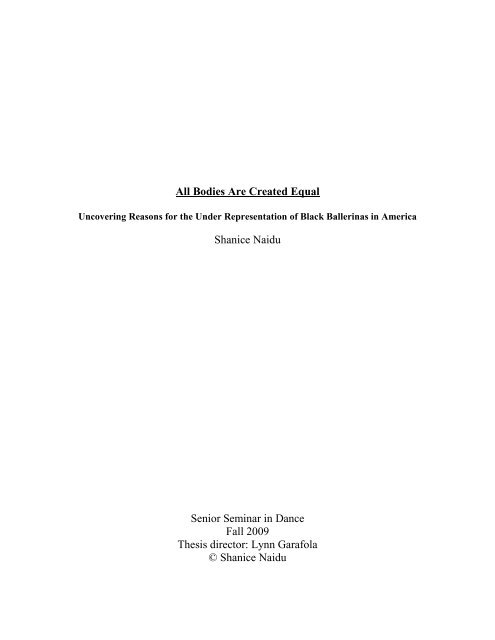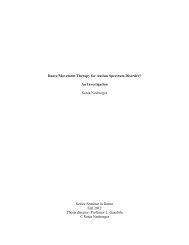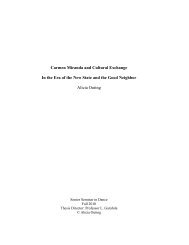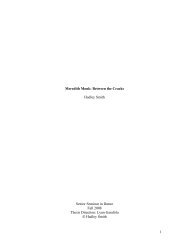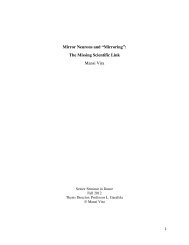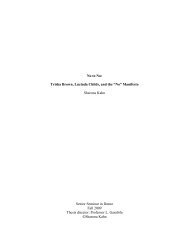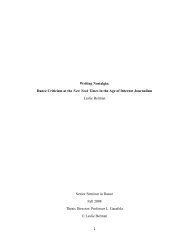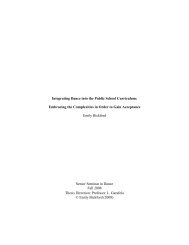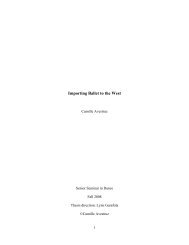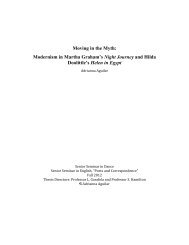Senior Thesis: 5-6 Pages - Dance - Barnard College
Senior Thesis: 5-6 Pages - Dance - Barnard College
Senior Thesis: 5-6 Pages - Dance - Barnard College
You also want an ePaper? Increase the reach of your titles
YUMPU automatically turns print PDFs into web optimized ePapers that Google loves.
All Bodies Are Created Equal<br />
Uncovering Reasons for the Under Representation of Black Ballerinas in America<br />
Shanice Naidu<br />
<strong>Senior</strong> Seminar in <strong>Dance</strong><br />
Fall 2009<br />
<strong>Thesis</strong> director: Lynn Garafola<br />
© Shanice Naidu
“<strong>Dance</strong> Theater of Harlem has eliminated all the old ideas about ballet and blacks, though<br />
I never said I was going to become a ballerina so that every little black girl in America could be<br />
one. I did it in the sense that, if you have a dream, whatever it is, if you put the discipline, and<br />
the commitment, and the love into it, you can achieve it.” 1 Virginia Johnson, one of the first<br />
prominent black professional ballerinas in the United States from the late 60s to when she retired<br />
from the stage, succinctly describes the significance of race in American ballet. Johnson<br />
acknowledges racial prejudice as limiting opportunities for black women to enjoy successful<br />
careers as ballerinas. She also notes that the creation of <strong>Dance</strong> Theatre of Harlem, a ballet<br />
company predominantly made up of black dancers, helped to dispel pervasive ideas about the<br />
black body and its ability to perform classical movement.<br />
Is Virginia Johnson right? Does it take only discipline, commitment, and love to achieve<br />
the goal of a black dancer to become a professional ballerina? In the United States, historically,<br />
unequal opportunities have prevented black dancers from pursuing amateur and professional<br />
training and performance opportunities in ballet.<br />
In addition to historical evidence, my personal experiences shed light on the inequalities<br />
faced by blacks in ballet. I became interested in writing about this topic because of my identity<br />
as a black dancer who has studied ballet. As a young dancer, it never really dawned on me that<br />
all the other students in my ballet classes were different from me. In middle school and high<br />
school, I began to hear snide comments, such as “Ballet is such a white thing to do” or “Only<br />
white people do ballet.” At the time, I ignored them. I continued to dance and even assisted my<br />
ballet teacher with her class. It is only now as a result of my undergraduate studies, that I have<br />
wanted to explain this disparity between white ballerinas (professional and amateur) and<br />
ballerinas who share my racial identity.<br />
1 Harper’s Bazaar, October 1988, 185.<br />
1
2<br />
My thesis includes a three- pronged argument that follows from the issue of race to the<br />
connotations of what particular races are capable of and/or should be doing. First, I will discuss<br />
the most evident layer of this disparity, which is race, followed by the misconceptions that<br />
continue to thrive in our society deriving from racial/cultural prejudice, and finally close with<br />
socioeconomic inequalities that are, at times, associated with specific races. In simple terms, I<br />
am addressing the question of whether or not the reality for aspiring black ballerinas is<br />
equivalent to the opportunities given, or at least provided for aspiring white ballerinas. By<br />
examining discriminatory laws, misconceptions based on traditional connotations of the art form,<br />
and socioeconomic disadvantages I hope to discover why black dancers are underrepresented in<br />
the ballet world and how this trend can be changed.<br />
First however, it is important to understand the relationship between the laws that helped<br />
to shape the perception of blacks in all aspects of life, including the perception of the black body,<br />
and general ideas, which led to the creation of these laws. Although the American Revolution<br />
was fought in the name of liberty and freedom for all Americans, slaves of African descent were<br />
not considered to be Americans, but property void of rights and liberties. Aside from the<br />
economic value of slaves, racial misconceptions led to unequal treatment of blacks in America.<br />
In 1787, Thomas Jefferson wrote,<br />
[T]he difference [between the races] is fixed in nature, and is real as if its seatand cause<br />
were better known to us…They secrete less by the kidneys, and more by the glands of the<br />
skin, which gives them a very strong and disagreeable odor…They are more ardent after<br />
their female; but love seems with them to be more an eager desire, than a tender delicate<br />
mixture of sentiment and sensation… [I]t appears to me, that in memory they are equal to<br />
the whites; in reason much inferior…In music they are more generally gifted than the<br />
whites with accurate ears for tune and time… 2<br />
2 Robert P. Green Jr., ed., Equal Protection and the African American Constitutional Experience : A<br />
Documentary History (Westport, CT: Greenwood Press, 2000), 26.
Jefferson provided an “intellectual” understanding of the difference between Africans and whites<br />
by addressing biological reasons for the inferiority of slaves. First, Jefferson asserted that all<br />
blacks have an unpleasant odor, which supports his claim that biology is the most dominant sign<br />
of their inferiority. Also, Jefferson addresses the sexual appetite of black men and their<br />
treatment of black women, which led to the notion of blacks as primitive and animalistic. The<br />
only positive attribute that Jefferson ascribes to blacks is their musicality: here they are more<br />
gifted than their white counterparts. If this idea were accepted without other prejudices, maybe<br />
the issue of underrepresented black ballerinas would not exist? However, the stereotype<br />
presented by Jefferson remains alive today. Blacks are praised for their music and dance<br />
abilities, but the styles they can master are affected by a history of prejudice and discriminatory<br />
treatment.<br />
Legal precedence reinforced this discrimination. In 1892, Homer Plessy, an African<br />
American man, was arrested for refusing to move from the white section of a train, which was<br />
required by the Louisiana Act of 1890. 3 Four years later, the United States Supreme Court ruled<br />
on the constitutionality of the statute. Specifically, Plessy argued that the law violated the Equal<br />
Protection Clause of the Fourteenth Amendment, which states: “No state shall…deprive any<br />
person of life, liberty, or property, without due process of law; nor deny to any person within its<br />
jurisdiction the equal protection of the laws 4 .” Ultimately, the Court ruled that segregation was<br />
constitutional. Justice Brown wrote the majority opinion:<br />
3 Green, 157.<br />
4 Green, 117.<br />
We consider the underlying fallacy of the plaintiff’s argument to consist in the<br />
assumption that the enforced separation of the two races stamps the colored race with a<br />
badge of inferiority…The argument also assumes that…equal rights cannot be secured to<br />
the negro except by an enforced commingling of the two races. We cannot accept this<br />
proposition. If the two races are to meet on terms of social equality, it must be the result<br />
of each other’s merits and a voluntary consent of individuals…If one race be inferior to<br />
3
4<br />
the other socially, the Constitution of the United States cannot put them upon the same<br />
plane…” 5<br />
In other words, the United States Supreme Court did not rule in favor of Plessy because the<br />
majority did not interpret segregation between whites and blacks as a violation of the Equal<br />
Protection Clause. According to Justice Brown, segregation did not define blacks as an inferior<br />
race. Furthermore, the majority held that judicial authority could not mend the social inequalities<br />
between blacks and whites; only voluntary acceptance of integration can fix social injustices.<br />
However, this finding could not be more flawed. The decision of Plessy v. Ferguson<br />
legalized segregation, which denied access to equal protection of the law as guaranteed by the<br />
Fourteenth Amendment. Black Americans were blatantly denied liberties that white Americans<br />
were granted. This second-class treatment of blacks supported the notion that blacks were<br />
inferior to whites. Furthermore, segregation prevented black dancers from sharing formal ballet<br />
training and performing on the same stage with white dancers.<br />
In 1954, the Supreme Court declared segregation unconstitutional in Brown v. Board of<br />
Education of Topeka, Kansas. The majority opinion states:<br />
…there are findings below that the Negro and white schools involved have been<br />
equalized, or are being equalized, with respect to buildings, curricula, qualifications…We<br />
must look instead of the effect of segregation itself on public education…We must<br />
consider public education in the light of its full development and its present place in<br />
American life throughout the Nation…To separate them from others of similar age and<br />
qualifications solely because of their race generates a feeling of inferiority as to their<br />
status in the community that may affect their hearts and minds in a way unlikely ever to<br />
be undone…‘Segregation of white and colored children in public schools has a<br />
detrimental effect upon the colored children. The impact is greater when it has the<br />
sanction of the law; for the policy of separating the races is usually interpreted as<br />
denoting the inferiority of the Negro group…’ Separate educational facilities are<br />
inherently unequal. 6<br />
5 Green, 158-159.<br />
6 Green, 244-245.
The Court unanimously concluded that segregation was unconstitutional because the very act of<br />
separating students by race carried with it the stigma of inequality. This decision transformed<br />
the opportunities made available to black dancers who desired to pursue a formal education in<br />
dance. However, customary discrimination continued, despite the legal changes. As I will<br />
discuss in a later section, this prevented the achievement of total equality for blacks.<br />
Furthermore, formal education in dance met with even greater obstacles resulting from<br />
perceptions of the black body. As exemplified by the beliefs of Jefferson, blacks were viewed as<br />
“primitive” creatures. This demeaning quality associated with blacks affected their presence in<br />
the performing arts world. According to African-American theater scholar, Annemarie Bean, the<br />
cultural expectations of blacks restricted the styles of art that African Americans could pursue.<br />
An understanding of the performing African-American body must depart from the<br />
historical insight that this body is bound by its portrayal in white culture as inherently<br />
entertaining in its subjection. As Saidiya V. Hartman points out, “torture and torment<br />
both generated enjoyment” in the two arenas in which African-Americans were primarily,<br />
though not exclusively, presented and re-presented as public spectacle in the nineteenthcentury:<br />
as the actual black body in pain on the auction block and the re-presentation of<br />
that black body on the popular stage by white performers. Therefore, our American<br />
image of the performing African-American has been performed through certain<br />
expectations ingrained through a history of slavery and oppression, as well as of mimetic<br />
containment. 7<br />
Bean examines the perception of the black body in a broad performance context. She<br />
acknowledges the historical connotations of the black body, as a result of the economic structure<br />
of slavery and the treatment of slaves of African descent as property subjected to public<br />
inspection. The concept of placing human beings on display for the sake of profit led to the<br />
American cultural expectation of using blacks as a source of ridicule and mockery. Thus,<br />
blackface minstrelsy became a popular form of American entertainment that lasted well into the<br />
7 Annemarie Bean ed., A Sourcebook on African-American Performance : Plays, People, Movements<br />
(New York: Routledge, 1999), 2.<br />
5
twentieth century. The persistence of such performance forms and acceptance of the ideas<br />
associated with them coincide with the unequal platform laid out for blacks in American history.<br />
Furthermore, the expectations for black performers and depiction of blacks as uncivilized<br />
counterparts to whites support the notion that the black body is incapable of learning and/or<br />
executing ballet.<br />
6<br />
Before black dancers could even attempt to learn and perform ballet in America, the<br />
black community needed to dispel the notion that they were incapable of entering society<br />
through the performing arts. Prior to Brown, American law reinforced a cultural distinction<br />
between blacks and whites. As theater historian David Krasner explains, “black high modernists<br />
envisioned a…social order that demanded an image distinct from minstrelsy…They attempted to<br />
correct injustices by imposing an alternative perception of African America 8 .” For example, the<br />
literary achievements of the Harlem Renaissance (early 1920s to mid-1930s) provided a mode<br />
for artistic expression of the African-American experience through the eyes of African<br />
Americans. Langston Hughes, in 1926, best encapsulates the significance of the Harlem<br />
Renaissance in his essay, “The Negro Artist and the Racial Mountain”:<br />
We younger Negro artists who create now intend to express our individual dark-skinned<br />
selves without fear or shame. If white people are pleased we are glad. If they are not, it<br />
doesn’t matter. We know we are beautiful. And ugly too…We build our temples for<br />
tomorrow, strong as we know how, and we stand on the top of the mountain, free within<br />
ourselves. 9<br />
Hughes described the importance of freedom of expression without catering to white<br />
expectations, especially when these expectations were based on misrepresentations of blacks.<br />
This idea coincided with the necessity for black artists to express the diversity of their culture.<br />
8 David Krasner, A Beautiful Pageant: African American Theatre, Drama, and Performance in the<br />
Harlem Renaissance, 1910-1927 (New York: Palgrave Macmillan, 2002), 14.<br />
9 Paul Finkelman, Encyclopedia of African American History, 1896 to Present: From the Age of<br />
Segregation to the 21 st Century, Vol.2, (New York: Oxford University Press, 2009), 373.
Thus, individuals of high cultural standing within the black community began to define<br />
acceptable forms of art. This was clearest in the literary field. In music and dance, a more<br />
hybrid process was at work.<br />
According to Krasner, “black modernity was a complex mixture of ideas and<br />
movements- migratory, urbanized, intellectualized, fragmentary, literary, folk, jazz, blues<br />
rhythmic, Western, and Afro-centric that created a complex, hybrid form…Black modernity<br />
represented a desire to transform the image of black culture from minstrelsy to sophisticated<br />
urbanity.” 10 The black aesthetic, which grew out of a desire by blacks to create a more accurate<br />
image of self, represented the diversity of black culture in America, incorporating traditional<br />
African and contemporary black American forms, including jazz and blues. The work produced<br />
and performed by Katherine Dunham exemplifies this aesthetic and its popularization and<br />
acceptance into mainstream American culture.<br />
Dunham created a unique style of dance incorporating formal training in ballet, modern<br />
dance, and Afro-Caribbean movement. Her stage and on-screen performances earned her great<br />
popularity spanning from the 1930s to 1960s. Like many New Negro artists, Dunham sought a<br />
reconstruction of social and cultural identity. In 1935, as a student of anthropology at the<br />
University of Chicago, Dunham was awarded a Rosenwald fellowship, which funded her trip to<br />
Haiti, Jamaica, and other countries in the West Indies. Dunham used anthropological methods of<br />
analysis to gain a better understanding of her personal roots and the African-American<br />
experience. Based on her research, Dunham developed her own technique, which she taught at<br />
her school in New York. “The Dunham technique included anatomical bases of ballet and<br />
10 David Krasner, A Beautiful Pageant, 10.<br />
7
modern dance that emphasized the torso movements of the primitive ritual of Caribbean-African<br />
dance and jazz rhythms.” 11<br />
8<br />
While the Dunham technique broke the minstrelsy conventions that limited performing<br />
arts opportunities for African-Americans, the popularity of Dunham’s work crystallized the<br />
notion that blacks were capable of only learning and performing “primitive” dance. For<br />
example, in a 1944 promotional advertisement for Dunham’s Tropical Revue words such as<br />
“heatwave”, “voodoo”, and “primitive” are used to describe the show. 12 The acceptance of<br />
Dunham’s work and technique rested on the exotic appeal of her movement and dancers.<br />
Although Dunham created a style that showcased the talent of black dancers, they were still not<br />
considered to be on the same level as white dancers.<br />
During the 1960s many blacks embraced an aesthetic of artistic and political<br />
empowerment, following the end of legal segregation. “Black Art is the aesthetic and spiritual<br />
sister of the Black Power concept. As such, it envisions an art that speaks directly to the needs<br />
and aspirations of Black America. In order to perform this task, the Black Arts Movement<br />
proposes a radical reordering of the western cultural aesthetic.” 13 As defined by Annemarie<br />
Bean, the new black aesthetic heightened the clash between the “classical” art of ballet and the<br />
“primitive” or exotic style of black dance, exemplified by Dunham. This new expression of<br />
African-Americans conflicted with the notion that black dancers were capable of performing<br />
ballet.<br />
This was complicated by the history of ballet in America. “Until 1940,” critic Anita<br />
Finkel has written, “there was virtually no American tradition of ballet, and it was Ballet Theatre<br />
11 Kaiso! : Writings By and About Katherine Dunham, d. . Clark and Sara E. Johnson.<br />
(Madison: University of Wisconsin Press, 2005), 179.<br />
12 Kaiso!, Figure 11<br />
13 Annemarie Bean ed., A Sourcebook on African-American Performance : Plays, People, Movements,<br />
(New York: Routledge, 1999), 55.
(as ABT was known from 1940 to 1957) that successfully established the notion of a native<br />
company as viable, flourishing thing…a company that would equal European companies in<br />
scale, grandeur, and prestige.” 14 Crucially, the aesthetic of ballet was associated with Europe,<br />
the same continent of powers that had organized the African slave trade to their respective<br />
colonies. "Of course, not every American intellectual was sure of the New World's ability to<br />
receive the inherited torch of Western culture,” American historian Gordon Wood has written,<br />
“and some doubted whether America's primitive tastes could ever sustain the fine arts.” 15 The<br />
most striking word out of this passage is “primitive.” During the revolutionary period, European<br />
culture was highly esteemed. Indeed, the argument for European cultural superiority and<br />
American primitivism parallels the argument presented for white American cultural elitism in<br />
contrast to black American primitivism. White Americans were viewed as superior, capable of<br />
performing “classical” techniques, despite the fact that Europeans did not view them in that same<br />
light. Thus, blacks were considered to lack the ability to pursue ballet training because of their<br />
excellence in “primitive” forms, such as jazz, Afro-Caribbean, tap, and popular dances. In other<br />
words, the European origin of ballet along with the categorization of black dance as “primitive”<br />
identified classical ballet in America as an art form pursued by white dancers.<br />
Despite discriminatory laws and the cultural connotations of words, such as “classical”<br />
and “primitive,” black dancers attempted to break the mold by pursuing an art form that they<br />
were told they could not accomplish. Joan Myers Brown, founder of PHILIDANCO!, was one<br />
of those dancers. During her early years of training, the cultural standards surrounding ballet<br />
limited Brown’s access to formal education in the art form. Brown attributes skin color as the<br />
dominant reason for discrimination, especially during the 1930s and 1940s when segregation was<br />
14 Anita Finkel, International Dictionary of Ballet, Vol. 1. Detroit: St. James, 1993, 19.<br />
15 Gordon S. Wood, The American Revolution: A History, (New York: Modern Library, 2002), 97.<br />
9
sanctioned by law. In an interview with <strong>Barnard</strong> student Aliya Mosby, Brown described the<br />
process of casting for school performances at her segregated elementary school in Philadelphia:<br />
“only the light-skinned girls with long, flowing hair got the leading parts.” 16 Even in an all-black<br />
school, skin color was a determining factor of potential opportunities in the dance field.<br />
10<br />
The issue of skin lightness or darkness within the black community permeated American<br />
culture. According to the dance historian Brenda Dixon Gottschild:<br />
In brief, there seem to be several reasons why blacks and whites privilege light skin over<br />
dark: (1) whites feel more at ease with people who look more like them; (2)<br />
consequently, blacks whose skin color looked more like whites were frequently able to<br />
gain economic advantages not accessible to their darker siblings…(4) thus, the lighter the<br />
skin the more the black person had a natural passport to some small measure of white<br />
advantage, in both black and white worlds. 17<br />
Thus, blacks who were unable to “pass” were denied entry into white areas of culture, such as<br />
ballet. In fact, one of Brown’s earliest dance instructors, Essie Marie Dorsey, was a black<br />
woman who “passed as Spanish in order to be able to study ballet and Spanish dancing.” 18<br />
Another teacher, Marion Cuyjet, throughout her professional training passed for white in order to<br />
take classes. “Cuyjet danced with the Littlefield Ballet until her cover was blown when black<br />
friends visited her backstage after a performance. Like Dorsey, Cuyjet used her fair skin to<br />
benefit from training and performance opportunities most blacks could not receive.” 19<br />
Aside from her training experience, Brown encountered racism as a performer. In 1953,<br />
she appeared in the ballet staged in Philadelphia by the English choreographer Anthony Tudor,<br />
16<br />
Aliya Mosby, “Joan Myers Brown: A Life of Combatting Racism” (<strong>Senior</strong> <strong>Thesis</strong>, <strong>Barnard</strong> <strong>College</strong>,<br />
2006), 6.<br />
17<br />
Brenda D. Gotthschild, The Black Dancing Body: A Geography From Coon to Cool, (New<br />
York: Palgrave Macmillan 2003), 191.<br />
18<br />
Aliya Mosby, “Joan Myers Brown: A Life of Combatting Racism” (<strong>Senior</strong> <strong>Thesis</strong>, <strong>Barnard</strong> <strong>College</strong>,<br />
2006), 6.<br />
19 Mosby, 10.
Les Sylphides. 20 In a review of the performance, a critic referred to Brown as a “‘fly in the<br />
buttermilk.’” 21 According to the critic, Brown’s skin color stood out among the white dancers,<br />
which spoiled the image of the whiteness both visually and culturally. By comparing Brown to a<br />
fly that does not belong in buttermilk, the critic implied that blacks did not belong in ballet<br />
classes or performances.<br />
This pervasive racism became evident to Joseph Rickard, founder of the First Negro<br />
Classic Ballet, in 1946 when he witnessed a black student in Hollywood being turned away from<br />
a ballet studio because of her race. 22 As a result, Rickard founded an integrated ballet school in<br />
Los Angeles that lasted from 1946 to 1956. This period marks a transformative period in US<br />
race relations. 23<br />
Raven Wilkinson, the first black woman to dance full-time in a ballet company<br />
exemplifies the significance of skin color American ballet during the transformation from racial<br />
segregation to integration. Wilkinson auditioned two or three times for the Ballet Russe de<br />
Monte Carlo before being hired in 1955, 24 a year after the landmark decision of Brown v. Board<br />
of Education. Fortunately, Wilkinson was given a chance to display her talents; by her second<br />
season with the Ballet Russe she was dancing the waltz solo in the ballet Les Sylphides.<br />
Unfortunately, Wilkinson had to deal with the reality of her skin color in the third year of<br />
her tenure with the Ballet Russe. Until then, she was able to perform in the South because of her<br />
light skin color. 25 However, in 1958, when the company played in Montgomery, Alabama, two<br />
20<br />
Mosby, 14.<br />
21<br />
Mosby, 14.<br />
22<br />
Kenneth H. Marcus, “’A New xpression For a New People’: Race and Ballet in Los Angeles, 1946-<br />
1956”, Journal of the West, 44, no. 2 (Spring 2005), 24.<br />
23<br />
Marcus, 24.<br />
24<br />
I'll Make Me a World. The Dream Keepers. Dir. Tracy H. Strain. Blackside Inc. in association with<br />
Thirteen/WNET, 1999.<br />
25<br />
Ballets Russes. Dir. Danya Goldfine, Dan Gellar, Robert Hawk, and Douglas B.<br />
11
Ku Klux Klan men walked down the aisles of the theater and came on stage shouting, “Hey!<br />
Where is the nigger?” 26 Fortunately, Wilkinson’s life was not in danger because of her ability to<br />
“pass,” but the company sent her home whenever the tour hit the South.<br />
12<br />
Outside of the dance field, situations motivated by outrage to the new legal precedence<br />
placed African Americans’ lives in fear. September 1957 marked a pivotal change in America<br />
with the most famous execution of the decision in Brown. Nine black students entered the halls<br />
of a once segregated high school. Only three weeks before this, Governor Orval Faubus claimed<br />
that integration at Central High in Little Rock, Arkansas would never happen, voicing the<br />
sentiments held by many, 27 despite the fact that Brown had made segregation unconstitutional.<br />
While the decision was a significant turning point in US race relations, the transition from<br />
segregation to integration met with obstacles that prevented complete progress for blacks. As for<br />
Wilkinson, she was, gradually, encouraged by the company to leave, marking the end of her<br />
professional dancing career in America. 28<br />
Race was not the only factor shaping the opportunities for aspiring professional<br />
ballerinas. As early as the 1930s and 1940s, Joan Myers Brown cites socioeconomic<br />
disadvantages as a hindrance to equal performance and educational opportunities. Specifically,<br />
family wealth affected both the training and performance opportunities. According to Brown,<br />
“‘Well, Dr. So and So’s daughter was featured [in a school recital] where the rest of us were just<br />
not, we were just there. And I think it was about class more than color, but most of the people in<br />
that class situation were light-skinned because their fathers were caterers, doctors, lawyers.” 29<br />
Turbaugh. Zeitgeist Films/Zeitgeist Video, 2006.<br />
26 Ballets Russes.<br />
27 Kevin Chappel1, “50 Years After Little Rock,” Ebony Magazine, (October 2007), 237.<br />
28 Ballets Russes.<br />
29 Aliya Mosby, 7.
Classes, essential to ballet training, cost money, and many black families could not afford them.<br />
On top of the misconception that blacks were incapable of performing ballet, socioeconomic<br />
disadvantages prevented all but a small minority from pursuing a professional ballet career.<br />
Fortunately, Brown continued her pursuit of a professional career as a ballerina. In 1970,<br />
she founded PHILADANCO!, a company providing the opportunity for her students from the<br />
Philadelphia School of <strong>Dance</strong> Arts. to enter the professional dance world. At the time of the<br />
creation of the company, sixteen years had passed since the overturn of Plessy. African<br />
American dancers in pursuit of professional dance careers went to New York because of the<br />
wider market for performance opportunities. 30 Unfortunately, “due to financial or family<br />
reasons, Brown’s students either could not or did not want to New York, and thus became the<br />
original members of PHILIDANCO!” 31 In other words, Brown provided formal ballet education<br />
and performance opportunities to those who were burdened by racial and socioeconomic<br />
discrimination.<br />
Interestingly, only a year before the founding of PHILADANCO!, Arthur Mitchell had<br />
created a similar company in New York. Mitchell was the first black principal dancer of the<br />
New York City Ballet during the 1950s. 32 I was fortunate to observe a master class in Miller<br />
Theatre at Columbia University on November 10 of this year, in which Mitchell briefly<br />
described his experience of receiving formal training in dance. During his early years, people<br />
encouraged him to pursue other styles, such as modern, jazz, tap, and African, but not ballet. He<br />
attributes this prejudice to his race (and gender too). 33 Despite his success, people would tell him<br />
30<br />
Mosby, 23.<br />
31<br />
Mosby, 23.<br />
32<br />
Martha Bremser ed. “Arthur Mitchell” International Dictionary of Ballet. Vol. 1-2. Detroit: St.<br />
James, 1993, 330.<br />
33<br />
Arthur Mitchell, Harlem Arts at Columbia University, Miller Theatre, Columbia University, 10<br />
November<br />
13
that he was an exception. 34 Mitchell did not let that steer him away from his dream of becoming<br />
professional ballet dancer, which he attained in 1955, a year after the end of legal segregation,<br />
when he pined the New York City Ballet.<br />
14<br />
Fourteen years later, Mitchell founded a dance company “to serve the black community<br />
in Harlem and, on a wider scale, to prove to the world that black dancers can excel in an art form<br />
which has been traditionally been a somewhat precious, whites-only preserve.” 35 His decision to<br />
create a company of black dancers was a response to the assassination of Martin Luther King, Jr.<br />
in 1968. The creation of <strong>Dance</strong> Theatre of Harlem provided a space and learning environment<br />
for black dancers who exhibited facility and dedication, but did not have equal opportunity for<br />
expression.<br />
Fortunately, Mitchell, along with his mentor and teacher Karel Shook, were able to start a<br />
successful company because of changes in the legal environment. Integration of blacks in<br />
traditional white schools provided greater access to formal technical training, which is necessary<br />
to become a strong dancer, as I know from my personal training and as Mitchell emphasized,<br />
during his master class at Columbia. Today, aspiring black ballerinas can access a broader<br />
spectrum of pre-professional instruction. The growing participation of blacks in ballet has<br />
started to change perceptions of black dancers’ capabilities in mastering the form. Learning<br />
ballet as a black American is no longer an matter of passing.<br />
<strong>Dance</strong> Theatre of Harlem performed a repertory of modern works, including several<br />
neoclassical ballets by George Balanchine, but Mitchell and Shook felt it was also important for<br />
the company to perform works intimately associated with the very idea of classicism. Hence<br />
2009.<br />
34 Arthur Mitchell, 10 November, 2009.<br />
35 Bremser, “<strong>Dance</strong> Theatre of Harlem,” International Dictionary of Ballet, Vol. 1, (Detroit:<br />
St. James Press, 1993), 330.
their decision to stage Giselle, the 1841 classic of the Romantic tradition, but setting it not in the<br />
German Rhineland, but in antebellum Louisiana. However, apart from the change in costuming<br />
and setting, Creole Giselle had a traditional choreographic text. 36<br />
The use of classical movement, the narrative, and choreographic conventions, such as<br />
partnering, pointe work, and the formalized pas de deux all are true to the core traits of ballet.<br />
As Martha Bremser pointed out, “This ‘Creole’ Giselle was meticulously researched and<br />
extremely effective in its new setting, yet at the same time utterly true to Romantic spirit and<br />
required early nineteenth-century balletic style.” 37 <strong>Dance</strong> Theatre of Harlem had made it clear<br />
that blacks could dance ballet.<br />
There is significance in the fact that costuming and setting were changed to appeal more<br />
to an African-American audience.<br />
Performers of the Harlem Renaissance, like all performers, required an audience. For<br />
African American performers, however the looming issue was whether to appeal to<br />
fellow blacks, to ‘cross over’ and perform for whites, or attempt to appeal to both. Many<br />
experienced the pressures to create for several audiences- white, black, middle class, and<br />
working class- and tried to accommodate as many groups as possible simply in order to<br />
survive. 38<br />
Although this quote depicts the necessity for artistic appeal to an audience, during the Harlem<br />
Renaissance, a primary contribution of “Creole Giselle” was to set a ballet that an American<br />
audience can relate to during the 1970s and 1980s. In other words, Mitchell was aware of the<br />
multiple audiences for his company. In order for his work to connect with the <strong>Dance</strong> Theatre of<br />
Harlem dancers as well as its new patrons, he drew upon history to make Giselle stay true to the<br />
black experience: hence, the Louisiana setting.<br />
36 Creole Giselle, Thomas Grimm, Prod. Yanna K. Brandt, Kultur, 1988, Videocassette.<br />
37 Bremser, “<strong>Dance</strong> Theatre of Harlem,” 331.<br />
38 David Krasner, A Beautiful Pageant, 8.<br />
15
16<br />
The relaxing legal and racial tensions that led to the success of <strong>Dance</strong> Theatre of Harlem<br />
is also reflected in progress for black dancers in attaining a formal ballet education and access to<br />
performance opportunities. Still, racial connotations continue to exist. Here is how Martha<br />
Bremser describes the DTH dancers in International Dictionary of <strong>Dance</strong> as late as 1993: “The<br />
dancers leading the troupe were by no means technical virtuosos, but the most immediately<br />
palpable quality about their dancing was the visible energy and enthusiasm of their attack.” 39<br />
Isn’t attack virtuosic? Why does energy stand out as opposed to the technique and lines of the<br />
body? The way dance critics view <strong>Dance</strong> Theatre of Harlem dances and dancers remain<br />
influenced by the issue of race in dance, at least subconsciously.<br />
Annemarie Bean acknowledges the nationalist pressures that weighed on dancers of early<br />
<strong>Dance</strong> Theatre of Harlem:<br />
Many of them [black dancers] had trained in ballet and established modes of American<br />
modern dance, two forms which had been created from a Europeanist vantage and for a<br />
largely white audience. The separatist demands of the nationalist moment precluded an<br />
acknowledgment of Eurocentric dance heritage; still, young black dancers respected the<br />
amount of information their bodies contained from intensive studio training. Even as<br />
younger dance artists strove to find forms which could be identified as conforming to an<br />
emergent black aesthetic, they could not easily dismiss their dance training as<br />
“inappropriately white.” 40<br />
Indeed, as increasing numbers of black dancers receive advanced training in Eurocentric<br />
techniques, they remain divided about their artistic goals. Few want to dismiss entirely the<br />
training they have worked so hard to acquire. Even in 2009, we cannot completely rule out the<br />
significance of race as an impediment for black dancers with a desire to pursue a career in ballet.<br />
Fortunately, legal and political trends have eliminated segregation from dance training and<br />
performance sites.<br />
39 Bremser,“<strong>Dance</strong> Theatre of Harlem,” 331.<br />
40 Bean, A Sourcebook on African-American Performance, 85.
A founding member of <strong>Dance</strong> Theatre of Harlem, Virginia Johnson, exemplifies the<br />
opportunities given to black dancers as a result of the legal and cultural changes of recent US<br />
history. Raised in segregated Washington, Johnson initially trained at an all black school. By<br />
1963, thanks to Brown, Johnson received a scholarship to train at the Washington School of<br />
Ballet. Her ability to access an outstanding pre-professional education in ballet resulted directly<br />
from the legal end to segregation.<br />
Johnson faced a major setback when it came time for her to enter the professional world:<br />
“I spent six years at the Washington School of Ballet being trained to be a very fine ballet<br />
dancer. Then, suddenly, in my senior year in high school, they said to me, ‘We think you should<br />
try jazz or become a modern dancer. We don’t think you’re going to get a job as a ballet<br />
dancer…’ There were no ballet companies in America that had black women dancers.” 41 The<br />
reality of the situation was that misconceptions of the black body still prevailed. Although<br />
changes were being made on the level of education or rather access to education for black<br />
dancers, the market for black ballerinas did not open at the same rate.<br />
This setback did not deter Johnson from pursuing her dream. After graduating from high<br />
school, Johnson enrolled at New York University School of the Arts, which placed her in<br />
geographic reach of <strong>Dance</strong> Theatre of Harlem. In February 1969 Johnson signed an official<br />
contract and become a professional dancer of the company. 42<br />
The following excerpt from an interview published in Ballet Review best encapsulates the<br />
Johnson’s personal experience with <strong>Dance</strong> Theatre of Harlem and her understanding of the<br />
impact that such a company had on the ballet world for black dancers:<br />
I think that it was in the 1980s or maybe 1990s that DTH started to get a generation of<br />
young black dancers who were well trained and completely owned the fact that they were<br />
41 Lynn Garafola, “A Conversation with irginia Johnson,” Ballet Review. Vol. 33 , 2005, 52<br />
42 Garafola, 54.<br />
17
18<br />
ballet dancers. They came in, an there was no question in their minds that they could do<br />
ballet, that they should be doing it…This was completely different from where I started,<br />
which was, ‘Can I have permission to do ballet…’ There are black dancers in ballet<br />
companies around the country now, although I wish there were more black dancers in<br />
schools. Maybe things aren’t a hundred percent different now, but they’re eighty percent<br />
and moving. I think there’s a generation of artistic directions and an audience that expect<br />
things to be different, whereas in the 1950s and 1960s not only the companies but also<br />
the audiences were very resistant. No it’s not changed enough, but, yes we’re training<br />
wonderful dancers, and there are places for them to go, and it’s going to get better. 43<br />
Johnson captures the trajectory of black dancers in America who pursued a professional career in<br />
ballet. She acknowledges the significance of <strong>Dance</strong> Theatre of Harlem as a black ballet<br />
company in America. At a time when legal and cultural changes were challenging traditional<br />
notions of ballet, Arthur Mitchell had created a company that proved to America that blacks<br />
could dance ballet. The chief reason for the company’s success was the fact that integration<br />
enabled and encouraged aspiring black dancers to receive formal ballet training. Johnson is right<br />
to acknowledge that black dancers in America today no longer need to ask for permission to<br />
learn and perform ballet. She is right, too, in pointing out the role of the audience in accepting<br />
and formulating standards who can and should perform ballet. Finally, Johnson optimistically<br />
concludes that progress will continue.<br />
Johnson highlights as the problem the limited number of black dancers studying ballet.<br />
Taking classes is expensive. From a legal perspective, race does not seem to be the dominant<br />
obstacle for aspiring black dancers; rather socioeconomic factors are the main culprit preventing<br />
many from pursuing their dreams. In other words, it is no longer a question of whether or not<br />
laws dictate my right to share a stage with white peers; it is a matter of access to the resource of<br />
learning the discipline of ballet.<br />
When discussing the history of <strong>Dance</strong> Theatre of Harlem, Bremser speaks of the initial<br />
mission of the company:<br />
43 Garafola, 61.
Mitchell’s mission, as the publicity for the school now proclaims, was “to introduce<br />
young people, particularly those who were economically and culturally disadvantaged, to<br />
the beauty and discipline of dance.” Ballet was not the sort of thing that attracted the<br />
average Harlem youth off of the streets, but Mitchell lured enough students into the<br />
studio. 44<br />
Although the company’s mission statement has changed over the years, its core content remains<br />
applicable today. Mitchell’s company catered to those who were economically and culturally<br />
disadvantaged. which have seen through experiences faced by Brown, Wilkinson, Johnson, and<br />
Mitchell himself. Poverty & Race in America: The Emerging Agendas, edited by Chester<br />
Hartman, shows the historical connection between racial minorities and lower socioeconomic<br />
classes. Because of poverty, the pursuit of a formal education in ballet is more difficult to<br />
accomplish.<br />
Because of discriminatory laws, misconceptions based on traditional connotations of<br />
ballet and socioeconomic disadvantages, black dancers have been underrepresented in the ballet<br />
world. Yet, my research has led me to agree with irginia Johnson’s claim that love, discipline,<br />
and commitment are necessary components in achieving one’s dream. We see it from the 1930s<br />
to now. For example, Essie Marie Dorsey passed as a Spanish dancer in order to gain access of<br />
formal training. In turn, she was able to start off Joan Myers Brown with her training. Although<br />
the 1940s to mid-1960s were filled with racial tension, including the violent backlash of the Ku<br />
Klux Klan and the assassination of Martin Luther King, Jr., hope was not lost for black dancers<br />
because the founding of dance companies that catered to African Americans, including <strong>Dance</strong><br />
Theatre of Harlem and PHILADANCO!. More importantly, Brown v. Board of Education of<br />
Topeka, Kansas in 1954 destroyed the legal basis of segregation based on skin color.<br />
Despite the existence of customary discrimination, both Arthur Mitchell and Virginia<br />
Johnson achieved their goals of pursuing a professional career in ballet. As a result of their<br />
44 Bremser, ed., “<strong>Dance</strong> Theatre of Harlem,” 330.<br />
19
success and the principles embodied by <strong>Dance</strong> Theatre of Harlem, Americans are beginning to<br />
realize that all bodies are created equal. As stated by Mitchell, “There is not a black pirouette; a<br />
pirouette’s a pirouette.” 45 Ballet is not only for white dancers.<br />
20<br />
While the acceptance of black dancers in American ballet is a general trend today,<br />
smaller groups continue to share old beliefs. For example, the “outing” of Raven Wilkinson by<br />
another black woman in the 1950s because some blacks believed that passing was a betrayal to<br />
the race 46 is similar to my experience of dealing with the snide comments of my black peers.<br />
Unfortunately, some African-Americans still believe that blacks should not perform ballet<br />
because the art form is solely associated with white culture.<br />
Today, the predominant factor limiting black entry into the American ballet world has<br />
shifted from race to socioeconomic inequality. I base the following argument on observations<br />
and interactions with my peers until I entered college. The comments of my black peers in<br />
school only highlighted the fact that black dancers are still not perceived as capable of<br />
performing ballet. More importantly, my experiences reveal that the way blacks perceive<br />
themselves results in the low presence of black ballerinas. Although I did not do research<br />
directly focused on the psychological effects of discriminatory laws and misconceptions of ballet<br />
as opposed to “primitive” art forms, it is apparent that people are aware of these claims and that<br />
some have either internalized them as true or acknowledged the struggle of pursuing a career in<br />
ballet and consciously decided to choose another option. In terms of internalizing legal and<br />
cultural standards, the Brown decision explicitly acknowledges the detrimental effects of<br />
teaching, through segregation, that blacks are inferior to whites simply because of their skin<br />
color. Historically in America, the fact that black ballerinas did not have a strong presence in the<br />
45 I'll Make Me a World, 1999.<br />
46 I’ll Make Me A world, 1999.
dance field makes it no surprise that many blacks still struggle with the notion that blacks can<br />
dance ballet. Although blacks continue to question the presence of black dancers in ballet,<br />
education and performance opportunities have significantly changed since the 1930s.<br />
The presence of black dancers performing ballet will minimize the old prejudices. For<br />
instance, the popular television competition show, So You Think You Can <strong>Dance</strong> contributes to<br />
the American awareness of black dancers’ capabilities. The winner of the show during its third<br />
season was Sabra Johnson, a black dancer who performed a variety of styles including ballet or<br />
related forms, such as lyrical. Her skin color did not bother the American audience: she was<br />
voted America’s Favorite <strong>Dance</strong>r that year.<br />
In addition, the sociopolitical climate of America today prevents blatant discrimination<br />
based on skin color. Unfortunately, socioeconomic disadvantages continue to halt the dreams of<br />
black dancers who desire to pursue a recreational or professional career in ballet. My proposed<br />
solution is to incorporate the performing arts in public education. Minorities who cannot afford<br />
extra technique classes can be exposed the art form in public classrooms, which will help remove<br />
ballet’s elitist identity.<br />
Most importantly, as history has proven, time will facilitate progress, which leads me to<br />
believe that more and more black dancers will pursue formal training in ballet and create a more<br />
fair representation of black dancers in ballerinas in America.<br />
Bibliography<br />
Anderson, Jack. “Ballet Russe de Monte Carlo.” International Encyclopedia of <strong>Dance</strong>. New<br />
York: Oxford University Press, 1998.<br />
21
Ballets Russes. Dir. Danya Goldfine, Dan Gellar, Robert Hawk, and Douglas B.<br />
Turbaugh. Zeitgeist Films/Zeitgeist Video, 2006.<br />
Barzel, Ann, et al. "United States of America: An Overview." The International<br />
Encyclopedia of <strong>Dance</strong>. New York: Oxford University Press 1998.<br />
Bean, Annemarie, ed. A Sourcebook on African-American Performance : Plays, People,<br />
Movements. New York: Routledge, 1999.<br />
Bremser, Martha, ed. International Dictionary of Ballet. Vol. 1-2. Detroit: St. James,<br />
1993.<br />
Brown II, Christopher, ed. Still Not Equal: Expanding Educational Opportunity in<br />
Society. New York: Peter Lang, 2007.<br />
Chappel1, Kevin. “50 Years After Little Rock.” Ebony Magazine, October 2007, PAGE II.<br />
Clark, v A. “Dunham, Katherine.” The International Encyclopedia of <strong>Dance</strong>. New York:<br />
Oxford University Press 1998.<br />
Creole Giselle. Dir. Thomas Grimm. Prod. Yanna K. Brandt. Kultur, 1988.<br />
Videocassette.<br />
<strong>Dance</strong> Theatre of Harlem. Dir. Thomas Grimm. Home Vision, 1989. Videocassette.<br />
Deans, Ed. Joselli D. "Black Ballerinas Dancing On The Edge: An Analysis of The<br />
Cultural Politics in Delores Browne's and Raven Wilkinson's Careers, 1954—<br />
1985." Diss. Temple University, 2001.<br />
Dunning, Jennifer. "But First a School”: The First Fifty Years of the School of American<br />
Ballet. New York: Viking, 1985.<br />
Garafola, Lynn. “A Conversation with Virginia Johnson.” Ballet Review. Vol. 33. 2005. New<br />
Gotthschild, Brenda D. The Black Dancing Body: A Geography From Coon to Cool. New<br />
York: Palgrave Macmillan, 2003.<br />
Green Jr., Robert P., ed. Equal Protection and the African American Constitutional<br />
Experience : A Documentary History. Westport: Greenwood, 2000.<br />
Hartmann, Chester. Poverty & Race in America: The Emerging Agendas. Maryland:<br />
Lexington Books, 2006.<br />
I'll Make Me a World. The Dream Keepers. Dir. Tracy H. Strain. Blackside Inc. in<br />
association with Thirteen/WNET, 1999.<br />
22
Kaiso! Writings By and About Katherine Dunham. Ed. . Clark and Sara .<br />
Johnson. Madison: University of Wisconsin, 2005.<br />
Krasner, David. A Beautiful Pageant: African American Theatre, Drama, and<br />
Performance in the Harlem Renaissance, 1910-1927. New York: Palgrave<br />
Macmillan, 2002.<br />
Mazo, Joseph H. and Howard S. Kaplan. "Alvin Ailey American <strong>Dance</strong> Theater." The<br />
International Encyclopedia of <strong>Dance</strong>. New York: Oxford University Press, 1998.<br />
Mitchell, Arthur. Master Class With the <strong>Dance</strong> Theatre of Harlem’s Founder and Artistic<br />
Director. Harlem Arts at Columbia University. Miller Theatre at Columbia University. 10<br />
November, 2009.<br />
Mosby, Aliya. “Joan Myers Brown: A Life of Combatting Racism.” <strong>Senior</strong> <strong>Thesis</strong>, <strong>Barnard</strong><br />
<strong>College</strong>, 2006.<br />
Nelson, Angela M.S., ed. This is How We Flow: Rhythm in Black Cultures. Columbia:<br />
University of South Carolina, 1999.<br />
Ostlere, Hilary B. "<strong>Dance</strong> Theatre of Harlem." The International Encyclopedia of <strong>Dance</strong>.<br />
New York: Oxford University Press, 1998.<br />
Terhoeven, Andreas. "The Exotic Is No Longer Demanded: New York Alvin Ailey<br />
School." The International Encyclopedia of <strong>Dance</strong>. 1990.<br />
White-Dixon, Melanye P. “Marion Cuyjet: isionary of <strong>Dance</strong> ducation in Black<br />
Philadelphia (Pennsylvania). <strong>Thesis</strong>: EDD Temple University, 1987.<br />
Wood, Gordon S., The American Revolution: A History. New York: Modern Library,<br />
2002.<br />
23


